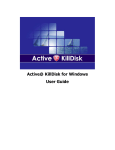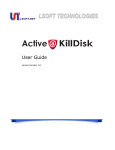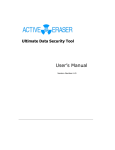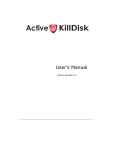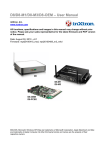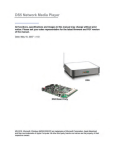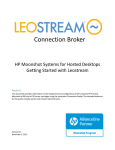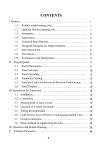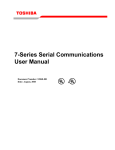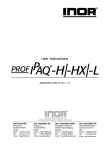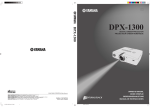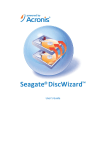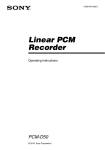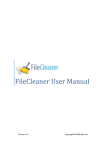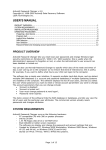Download Active@ KillDisk User Guide - How to erase hard drive by Active
Transcript
Active@ KillDisk for Windows User Guide Copyright © 2012, LSOFT TECHNOLOGIES INC. All rights reserved. No part of this documentation may be reproduced in any form or by any means or used to make any derivative work (such as translation, transformation, or adaptation) without written permission from LSOFT TECHNOLOGIES INC. LSOFT TECHNOLOGIES INC. reserves the right to revise this documentation and to make changes in content from time to time without obligation on the part of LSOFT TECHNOLOGIES INC. to provide notification of such revision or change. LSOFT TECHNOLOGIES INC. provides this documentation without warranty of any kind, either implied or expressed, including, but not limited to, the implied warranties of merchantability and fitness for a particular purpose. LSOFT may make improvements or changes in the product(s) and/or the program(s) described in this documentation at any time. All technical data and computer software is commercial in nature and developed solely at private expense. As the User, or Installer/Administrator of this software, you agree not to remove or deface any portion of any legend provided on any licensed program or documentation contained in, or delivered to you in conjunction with, this User Guide. Active@ KillDisk, the Active@ KillDisk logo, KillDisk and Erasers Software are trademarks of LSOFT TECHNOLOGIES INC. LSOFT.NET logo is a trademark of LSOFT TECHNOLOGIES INC. Other brand and product names may be registered trademarks or trademarks of their respective holders. 2 Active@ KillDisk User Guide Contents 1 Product Overview................................................................................................................ 4 1.1 Erasing Confidential Data.............................................................................................. 4 1.2 Wiping Confidential Data from Unoccupied Drive Space .................................................. 6 2 System Requirements ......................................................................................................... 7 2.1 Active@ KillDisk for Windows Version ............................................................................ 7 3 Running Active@ KillDisk ................................................................................................... 10 3.1 Active@ Boot Disk Creator .......................................................................................... 10 3.2 Modes of Operation .................................................................................................... 12 3.3 Erase or Wipe Operation Complete.............................................................................. 25 4 Common Questions ........................................................................................................... 27 5 Descriptions of Erase/Wipe Parameters .............................................................................. 29 6 Glossary of Terms ............................................................................................................. 32 3 1 Product Overview Active@ KillDisk for Windows is a powerful utility that will: · Wipe confidential data from unused space on your hard drive · Erase data from partitions or from an entire hard disk · Destroy data permanently Wiping the logical drive's deleted data does not delete existing files and folders. It processes all unoccupied drive space so that data recovery of previously deleted files becomes impossible. Installed applications and existing data are not touched by this process. Active@ KillDisk wipes unused data residue from file slack space, unused sectors, and unused space in MTF records or root records. When you erase data with Active@ KillDisk for Windows, you destroy data permanently, conforming to any one of six international standards or your own custom settings. Wiping drive space or erasing data can take a long time, so perform these operations when you are prepared to wait. For example, these operations may be run overnight. 1.1 Erasing Confidential Data Modern methods of data encryption are deterring unwanted network attackers from extracting sensitive data from stored database files. Attackers who want to retrieve confidential data are becoming more resourceful by looking into places where data might be stored temporarily. A hard drive on a local network node, for example, can be a prime target for such a search. One avenue of attack is the recovery of data from residual data on a discarded hard disk drive. When deleting confidential data from hard drives, removable floppies or USB devices, it is important to extract all traces of the data so that recovery is not possible. Most official guidelines around disposing of confidential magnetic data do not take into account the depth of today’s recording densities, nor the methods used by the operating system when removing data. For example, the Windows DELETE command merely changes the file name so that the operating system will not look for the file. The situation with NTFS is similar. Removal of confidential personal information or company trade secrets in the past might have used the FORMAT command or the DOS FDISK command. Ordinarily, using these procedures give users a sense of confidence that the data has been completely removed. 1 Product Overview When using the FORMAT command, Windows displays a message like this: Important: Formatting a disk removes all information from the disk. The FORMAT utility actually creates new FAT and ROOT tables, leaving all previous data on the disk untouched. Moreover, an image of the replaced FAT and ROOT tables are stored, so that the UNFORMAT command can be used to restore them. As well, FDISK merely cleans the Partition Table (located in the drive's first sector) and does not touch anything else. 1.1.1 Advanced Data Recovery Systems Advances in data recovery have been made such that data can be reclaimed in many cases from hard drives that have been wiped and disassembled. Security agencies use advanced applications to find cybercrime-related evidence. Also there are established industrial spy agencies adopting sophisticated channel coding techniques such as PRML (Partial Response Maximum Likelihood), a technique used to reconstruct the data on magnetic disks. Other methods include the use of magnetic force microscopy and recovery of data based on patterns in erase bands. Although there are very sophisticated data recovery systems available at a high price, data can easily be restored with the help of an off-the-shelf data recovery utility like Active@ File Recovery, making your erased confidential data quite accessible. Using Active@ KillDisk for Windows, our powerful and compact utility, all data on your hard drive or removable device can be destroyed without the possibility of future recovery. After using Active@ KillDisk for Windows, disposal, recycling, selling or donating your storage device can be done with peace of mind. 1.1.2 International Standards in Data Removal Active@ KillDisk for Windows conforms to four international standards for clearing and sanitizing data. You can be sure that once you erase a disk with Active@ KillDisk for Windows, sensitive information is destroyed forever. Active@ KillDisk for Windows is a quality security application that destroys data permanently from any computer that can be started using a bootable CD or DVD-ROM. Access to the drive's data is made on the physical level via the BIOS (Basic Input-Output Subsystem), bypassing the operating system’s logical drive structure organization. Regardless of the operating system, file systems or type of machine, this utility can destroy all data on all storage devices. It does not matter which operating systems or file systems are located on the machine. Active@ KillDisk for Windows User Guide 5 1 Product Overview 1.2 Wiping Confidential Data from Unoccupied Drive Space You may have confidential data on your hard drive in spaces where data may have been stored temporarily. You may also have deleted files by conveniently using the Windows Recycle Bin and then emptying the Recycle Bin. While you are still using your local hard drive, there may be confidential information available in these unoccupied drive spaces. Wiping the logical drive's deleted data does not delete existing files and folders. It processes all unoccupied drive space so that data recovery of previously deleted files becomes impossible. Installed applications and existing data are not touched by this process. When you wipe unoccupied drive space, the process is run from the bootable CD/DVD operating system. As a result, the wipe or erase process uses an operating system that is outside the local hard drive and is not impeded by Windows system caching. This means that deleted Windows system records can be wiped clean. KillDisk wipes unused data residue from file slack space, unused sectors, and unused space in MTF records or root records. Wiping drive space can take a long time, so perform this operation at a time when you are prepared to wait. For example, it is a process that can be run overnight. 6 Active@ KillDisk User Guide 2 System Requirements This chapter outlines the minimum requirements for PCs using Active@ KillDisk for Windows. Personal Computer IBM PC/AT compatible CPU Intel Pentium or higher 350 Mb of RAM Video must be VGA or better resolution (800 x 600) Drive Storage System CD or DVD-ROM drive USB storage device Hard Disk Drive type IDE, ATA, SSD, SATA or SCSI with controllers (additional drivers can be loaded for RAIDs or non-standard controllers after the system is booted up) Other Requirements One blank CD or DVD to burn an ISO image. 2.1 Active@ KillDisk for Windows Version The performance of Active@ KillDisk for Windows depends on the version of the application, as displayed in the table below. Table 2-1 Differences between Free and Professional Versions Feature Free Demo Version Professional Version Securely overwrites and destroys all data on physical drive or logical partition yes yes Erases partitions, logical drives and unused disk space yes yes Supports IDE / ATA / SATA / SCSI hard disk drives yes yes 2 System Requirements Feature Free Demo Version Professional Version Supports fixed disks, floppies, zip drives, USB devices yes yes Supports large-sized drives (more than 128 GB) yes yes Supports Command Line mode (can be run with no user interaction) yes yes Operates from bootable CD/DVD-ROM or bootable USB device yes yes Erases with one-pass zeros yes yes Erases with one-pass random characters yes Erases with user-defined number of passes (up to 99) yes US Department of Defense 5220.22 M compliant yes German VISTR compliant yes Russian GOST p50739-95 compliant yes Gutmann method compliant yes Customizable security levels yes Supports all detected hard disk drives yes yes Erasing report is created and can be saved as a file yes yes Displays detected drive and partition information yes yes Scans NTFS and FAT volumes and displays existing and deleted files and folders yes yes yes Data verification may be performed after erasing is completed 8 Disk Viewer allows you to preview any sectors or file clusters on a drive yes yes Dislplays Erase/Wipe certificate for printing yes yes Active@ KillDisk User Guide 2 System Requirements Feature Free Demo Version Professional Version Saves Erase/Wipe certificate to PDF yes yes Wipes out NTFS, FAT32, FAT16 and FAT12 volumes from areas containing deleted and unused data yes yes Wipes out free clusters (unused by file data sectors) yes yes Wipes out file slack space (unused bytes in the last cluster occupied by file) yes yes Wipes out deleted MFT and ROOT system records yes yes Wipes out unused space in any MFT records and compressed clusters yes yes Active@ KillDisk for Windows User Guide 9 3 Running Active@ KillDisk After you purchase Active@ KillDisk, you will receive an installation file named KILLDISK-SETUP.EXE. This file contains everything you need to get started. To install the application, double-click KILLDISK-SETUP.EXE and follow instructions on the installation wizard. The installed application contains two main applications: · Active@ KillDisk for Windows — Run this application from your Windows operating system to scan local drives. · Active@ Boot Disk Creator — Create a bootable CD/DVD or USB device and run Active@ KillDisk for Windows from the device. Using Active@ KillDisk this way allows you to wipe confidential data from the system cache and you can gain exclusive use of a partition because the operating system runs outside the partition that you are securing. 3.1 Active@ Boot Disk Creator Active@ Boot Disk Creator helps you prepare a bootable CD, DVD or USB mass storage device that you may use to start a machine and repair security access issues or destroy all data on the hard drives. To prepare a bootable device for Windows: 1. From the Windows Start menu, click All Programs > Active@ KillDisk > Bootable Disk Creator. The Active@ Boot Disk Creator main page appears. 2. In the Active@ Boot Disk Creator main page, select the desired bootable media: CD/DVD/Blu-ray, USB Flash Drive or ISO Image file (to be burned later on). If several media drives inserted, click the ellipsis button (…) and choose a particular device. Click Next. 3. Click Boot into Windows. At this step you can specify additional options: a. To add your custom files to bootable media, click User’s Files tab. Add files or folders using related buttons at the right side. Added items will be placed to User_Files root folder. b. To add specific drivers to be loaded automatically, click Add Drivers tab. Add all files for the particular driver (*.INF, *.SYS, …). Added items will be placed to BootDisk_Drivers root folder. At boot time all *.INF files located in this folder will be installed. c. To add specific scripts to be launched after Active@ Boot Disk is loaded, click Add Scripts tab. Add your scripts (*.CMD files). Added 3 Running Active@ KillDisk files will be placed to BootDisk_Scripts root folder. At boot time all *.CMD files located in this folder will be executed. d. To specify additional boot options, click Boot Settings tab. You can change default settings to be used: Time Zone, Additional Language Support, Network Support and Auto-start Delay. The same options you can change later on at the boot time on Active@ Boot Disk initialization screen. Click Next. Verify the Selected Media, Sizes and Boot up Environment. Click Create. A progress bar appears while media is being prepared. Note USB Drive or blank CD/DVD must be inserted and chosen explicitly on the first step, before you can proceed to the next step. Note When you prepare USB Flash Drive bootable media, it will be reformatted, thus all data residing on the media will be erased. You will have a choice of NTFS or FAT32 file system to be placed on USB. We recommend you to use FA32 for smaller volumes and NTFS for larger media size, it supports large volumes (>32GB) and file sizes (>2GB). Note If you’ve created ISO Image file, you can burn it up later on, either using our free Active@ ISO Burner utility ( www.ntfs.com/iso-burning.htm), or have a disk burning utility that you prefer to use, use it to burn the ISO to a disk. Active@ KillDisk for Windows User Guide 11 3 Running Active@ KillDisk 3.2 Modes of Operation Active@ KILLDISK for Windows can be used two ways: · Interactive Mode · Command Line Mode 3.2.1 Interactive Mode The steps for erasing data and wiping data are similar. Follow steps 1 through 10 and then click the link to complete either the erasing process or the wiping process. If you are booting from a CD/DVD-ROM drive, check that the drive has boot priority in the BIOS settings of your computer. Here are the steps for interactive operation: 1. Start the Active@ KILLDISK either from bootable CD/DVD, from a USB device or from the Programs menu. The Detected Physical Devices screen appears. Figure 3-1 Detected Physical Devices 12 Active@ KillDisk User Guide 3 Running Active@ KillDisk All system physical devices and logical partitions are displayed in a list. Hard drive devices are numbered by the system BIOS. A system with a single hard drive shows as number 0. Subsequent hard drive devices are numbered consecutively. For example the second device will be shown as Hard Disk 1. 2. Select a device and read the detailed information about the device in the right pane. Below the device, select a logical partition. The information in the right pane changes. 3. Be certain that the drive you are pointing to is the one that you want to erase or the one you want to wipe. If you choose to erase, all data will be permanently erased with no chance for recovery. To preview the sectors in a device, press CTRL + V or click View Data on the toolbar. The Data Viewer screen appears. Figure 3-2 Data Viewer 4. To scroll up and down, use the keyboard arrow keys, PAGE UP, PAGE DOWN, HOME and END navigation keys, or use the related buttons on the toolbar. 5. To jump to a specific sector, in the Sector box, type the sector number and press ENTER or click Go on the toolbar. Active@ KillDisk for Windows User Guide 13 3 Running Active@ KillDisk 6. When you are satisfied with the identification of the device, press ESC to close this screen. 7. To preview the files in a logical partition, select the partition and press ENTER. KillDisk scans the MFT records for the partition. The Folders and Files screen appears. Figure 3-3 Files Preview 8. Press TAB to move between panels or choose a panel with the mouse. 9. To select an item in the list, use PAGE DOWN, PAGE UP or the up or down arrow keys or use the mouse. 10. To open a folder, double-click the folder or select it and press ENTER. KillDisk scans the MFT records for this folder. The files in the folder appear in the right panel. Existing files and folders marked by yellow icons and deleted files and folders marked by gray icons. If you are wiping data from unoccupied areas, the gray-coloured file names are removed after the wiping process completes. You may use Data Viewer to inspect the work done by the wiping process. After wiping, the data in these areas and the place these files hold in the root records or MFT records are gone. 3.2.1.1 Erase Data from a Device When you select a physical device (for example, Hard Disk 0), the erase command processes partitions no matter what condition they are in. Everything must be destroyed. NOTE Because of the BIOS restrictions of some manufacturers, a hard disk device that is larger than 300 MB must have an MBR (Master Boot Record) in 14 Active@ KillDisk User Guide 3 Running Active@ KillDisk sector zero. If you erase sector zero and fill it with zeros or random characters, you might find that you cannot use the hard drive after erasing the data. It is for this reason that—on hard drives larger than 300 MB—KillDisk creates an empty partition table and writes a typical MBR in sector zero. If you want to erase data on selected logical drives, follow the steps in 3.2.3 Erase or Wipe Logical Drives (Partitions). To erase the data: 1. Be certain that the drive you are pointing to is the one that you want to erase. All data will be permanently erased with no chance for recovery. 2. When you have selected the device to erase, select the checkbox for this hard drive. To permanently erase all data on the selected partition, press F10 or click Kill on the toolbar. The Kill dialog box appears. Figure 3-4 Kill dialog box 3. To choose an erase method, select one from the drop-down list. Erase methods are described in Chapter 5 Descriptions of Erase/Wipe Parameters in this guide. Active@ KillDisk for Windows User Guide 15 3 Running Active@ KillDisk 4. Set other parameters for erasing. To specify lof file location and certificate options, click more options… link: For information on these parameters, see Chapter 5 Descriptions of Erase/Wipe Parameters in this guide. 5. Click Start. · If the Skip Confirmation check box is clear, the Confirm Action dialog box appears. Figure 3-5 Confirm Action 6. This is the final step before removing data from the selected drive for ever. Type ERASE-ALL-DATA in the text box and press ENTER or click YES. The Progress bar appears. 16 Active@ KillDisk User Guide 3 Running Active@ KillDisk 7. To stop the process at any time, press ESC. Please note, however that data that has already been erased will not be recoverable. Figure 3-6 Disk Erasing in Progress 8. There is nothing more to do until the end of the disk erasing process. The application will operate on its own. If there are any errors, for example due to bad clusters, they will be reported on the Interactive screen. If such a message appears, you may cancel the operation (by pressing ESC), or you may continue erasing data. NOTE Because of the BIOS restrictions of some manufacturers, a hard disk device that is larger than 300 MB must have an MBR (Master Boot Record) in sector zero. If you erase sector zero and fill it with zeros or random characters, you might find that you cannot use the hard drive after erasing the data. It is for this reason that—on hard drives larger than 300 MB—KillDisk creates an empty partition table and writes a typical MBR in sector zero. Active@ KillDisk for Windows User Guide 17 3 Running Active@ KillDisk 3.2.1.2 Wipe Data from a Device When you select a physical device (for example, Hard Disk 0), the wipe command processes all logical drives consecutively, deleting data in unoccupied areas. Unallocated space is not touched. If KillDisk detects that a partition has been damaged or that it is not safe to proceed, KillDisk does not wipe data in that area. The reason it does not proceed is that a damaged partition might contain important data. There are some cases where partitions on a device cannot be wiped; for example, if there is an unknown file system, or if the disk contains unallocated space. In these cases, the Wipe button is disabled. If you select a device and the Wipe button is disabled, select individual partitions (drives) and wipe them out separately. If you want to erase data from the hard drive device permanently, see 3.2.1.1 Erase Data. If you want to wipe data in unoccupied areas on selected logical drives, follow the steps in 3.2.3 Erase or Wipe Logical Drives (Partitions). To wipe data from a device: 1. To choose a device to wipe, select the check box next to the device name. You may select multiple devices. 2. To wipe all data in unoccupied sectors on the selected partitions, press F9 or click Wipe. The Wipe Free Disk Space dialog box appears. 18 Active@ KillDisk User Guide 3 Running Active@ KillDisk Figure 3-7 Wipe Free Disk Space 3. To select a wipe method, choose a method from the Wipe Method drop-down list. Wipe methods are described in Chapter 5 Descriptions of Erase/Wipe Parameters in this guide. 4. You may change other parameters in this dialog box. For information on these parameters, see Chapter 5 Descriptions of Erase/Wipe Parameters in this guide. 5. To advance to the final step before erasing data, click Start. If the Skip Confirmation check box is clear, the Confirm Action dialog box appears. Active@ KillDisk for Windows User Guide 19 3 Running Active@ KillDisk Figure 3-8 Confirm Action 6. This is the final step before wiping data residue from unoccupied space on the selected drive. After the process has started, you may stop it by pressing the ESC key. To confirm the wipe action, click Yes. Progress of the wiping procedure will be monitored in the Disk Wiping screen. 7. To stop the process for any reason, press the ESC key. Please note that all existing applications and data will not be touched, however, data that has been wiped from unoccupied sectors is not recoverable. 8. There is nothing more to do until the end of the disk erasing process. The application operates on its own. If there are any errors, for example due to bad clusters, they will be reported on the Interactive screen. If such a message appears, you may cancel the operation (by pressing ESC), or you may continue wiping data. 9. After the wiping process is completed, to inspect the work that has been done, select the wiped partition and press ENTER. KillDisk scans the MFT records or the root records of the partition. The Folders and Files tab appears. Existing file names and folder names appear with a multi-coloured icon and deleted file names and folder names appear with a gray-coloured 20 Active@ KillDisk User Guide 3 Running Active@ KillDisk icon. If the wiping process completed correctly, the data residue in these deleted file clusters and the place these files hold in the root records or MFT records has been removed and you should not see any graycoloured file names or folder names in the wiped partition. 3.2.2 Command Line Mode To run Active@ KillDisk in command line mode, you open a command prompt screen. At the command prompt, start Active@ KillDisk for Windows by typing: >killdisk_win.exe -? A list of parameters appears. You can find explanations of the parameters can be found in the table below. Table 3-2 Command Line Parameters Parameter Short Default no parameter -erasemethod=[0-6] Options With no parameter, the DOS Interactive screens will appear. -em= 0 0 - One pass zeros (quick, low security) 1 - One pass random (quick, low security) 2 - US DoD 5220.22-M (slow, high security) 3 - German VSITR (slow, high security) 4 - Russian GOST p50739-95 (slow, high security) 5 - Gutmann (very slow, highest security) 6 - User Defined Number of Passes (random) -passes=[1 - 99] -p= 3 Number of times the write heads will pass over a disk area to overwrite data. Valid only if -erasemethod = 6. -verification=[1 100] -v= 10 Set the amount of area the utility reads to verify that the actions performed by the write head comply with the chosen erasemethod (reading 10% of the area by default). It is a long process. Set the verification to the level that works for you. Active@ KillDisk for Windows User Guide 21 3 Running Active@ KillDisk Parameter Short Default -retryattempts=[1 99] -ra= 5 -erasehdd=[80h 8Fh] -eh= Name the hard drive to be erased. By default, the utility erases the first logical drive encountered. -eraseallhdds -ea Erase all hard disk drives. -ignoreerrors -ie -clearlog -cl Use this parameter to clear the log file before recording new activity. When a drive is erased, a log file is kept. By default, new data is appended to this log for each erasing process. The log file is stored in the same folder where the software is located. -logpath=[“fullpath”] -lp Path to save application log file. Can be either directory name or full file name. Use quotes if full path contains spaces. -certpath=[“fullpath”] -cp Path to save erase/wipe certificate. Can be either directory name or full file name. Use quotes if full path contains spaces. -noconfirmation -nc Skip confirmation steps before erasing starts. By default, confirmation steps will appear in command line mode for each hard drive or floppy as follows: OFF Options Set the number of times that the utility will try to rewrite in the sector when the drive write head encounters an error. Do not stop erasing each time a disk error is encountered. When you use this parameter, all errors are ignored. Are you sure? -beep -bp Beep after erasing is complete. -wipeallhdds -wa Wipe all hard drives. -wipehdd = [80h8Fh] -wh= Name the hard drive to be wiped. -test 22 If you are having difficulty with Active@ KillDisk for Windows, use this parameter to create a hardware information file to be sent to our technical support specialists. Active@ KillDisk User Guide 3 Running Active@ KillDisk Parameter Short Default Options -batchmode -bm Execute in batch mode based on command line parameters with no user interaction. -userpattern =[“fullpath”] -u File to get user-defined pattern from -help or -? Display this list of parameters. Note Parameters -test and -help must be used alone. They cannot be used with other parameters. Type the command and parameters into the DOS screen at the prompt. Here is an example: >killdisk_win.exe -eh=80 -bm In the example above, data on device 80h will be erased using the default method (one pass zeros) without confirmation and return to the DOS prompt when complete. Here is another example: >killdisk_win.exe -eh=80 -nc -em=2 In this example, erase all data on device 80h without confirmations, using US DoD 5220.22-M method, and show a report at the end of the process. Here is an example with the wipe disk command: >killdisk_win.exe -wa -bm -em=5 -nc Wipe all deleted data and unused clusters on all attached drives without confirmation using Gutman's method and return to the DOS prompt when complete. Press ENTER to complete the command and start the process. After operation has completed successfully information on how drives have been erased is displayed on the screen. 3.2.3 Erase or Wipe Logical Drives (Partitions) In all previous examples in this chapter, the process has erased data or wiped data from a physical drive. Using a similar method, you can erase or wipe logical disks and partitions, and even “Unallocated” areas where Active@ KillDisk for Windows User Guide 23 3 Running Active@ KillDisk partitions used to exist and the area was damaged, or the area is not visible by the current operating system. There are some cases where partitions on a device cannot be wiped; for example, if there is an unknown file system, or if the disk contains unallocated space. In these cases, the Wipe button is disabled. To perform the Wipe or Erase action you must lock the partition first. If another user or an application is using files on the partition, it cannot be locked. In this case a dialog box appears with information that the disk is being used and you need either skip it, or perform a “hard drive dismount”. If you skip it, the wipe or erase operation is canceled for this drive. If you select “hard dismount”, some data in the drive’s cache may be lost. 3.2.3.1 Erase Data from a Logical Drive To erase data from a logical drive: 1. Start Active@ KillDisk from a bootable device or from the Programs menu. 2. The Detected Physical Devices screen appears. All system hard drives and floppy drives are displayed in the left pane and system information is displayed in the right pane. Figure 3-9 Detected Physical Devices 24 Active@ KillDisk User Guide 3 Running Active@ KillDisk 3. Select the check box of a logical drive or next to the Unallocated area. 4. Press F10 or click Kill. The Kill dialog box appears. 5. Set erase method and set other parameters for erasing. For information on these parameters, see Chapter 5 Descriptions of Erase/Wipe Parameters in this guide. 6. Complete the process, similar to the process for devices. 3.2.3.2 Wipe Data from a Logical Drive To wipe data from a logical drive: 1. Start Active@ KillDisk from a bootable device or from the Programs menu. 2. The Detected Physical Devices screen appears. All system hard drives and floppy drives will be displayed in the left pane along with their system information in the right pane. 3. Select the check box of a logical drive. 4. Press F9 or click Wipe to wipe data from unoccupied areas. The Wipe Free Disk Space dialog box appears. 5. Select a wipe method and set other parameters for wiping. For information on these parameters, see Chapter 5 Descriptions of Erase/Wipe Parameters in this guide. 6. Complete the process, similar to the process for devices. 3.3 Erase or Wipe Operation Complete After operation is completed successfully, information on how drives have been erased or wiped is displayed. An example of an erase session is displayed below. ------------- Erase Session ----------------------Active@ KillDisk for Windows Build 6.0 started at: Thu Feb 20 11:56:51 2012 Target: Hard Disk 1 160GB Erase method: US DoD 5220.22-M (3 passes, verify) Pass 1 – 0x00 – completed 100% - Ok Pass 2 – 0xFF – completed 100% - Ok Pass 3 – Random – completed 100% - Ok Verification:40% - completed 100% - Ok Time taken: 00:30:26 Active@ KillDisk for Windows User Guide 25 3 Running Active@ KillDisk Total number of erased device(s), partition(s): 1 If the process encountered errors, for example from bad clusters, a summary of errors is presented in this report. Use the keyboard arrow keys to scroll through the report. To save the log file, press F2. Details of this report are saved to a log file located in the folder from which you started Active@ KillDisk. 26 Active@ KillDisk User Guide 4 Common Questions 4.1 How does the licensing work? The software is licensed on a per CD/DVD or USB device basis. Each license allows you to use the program from a separate CD/DVD or USB device. For example, if you want to use the program to wipe five computers concurrently, you would need five CDs or DVDs or USB devices (or combination of the three not exceeding five), and therefore need a five-user license. 4.2 How is the data erased? Active@ KillDisk communicates with the system hardware device directly. To erase data it overwrites all addressable locations on the drive with zeros (FREE version). Active@ KillDisk Professional version suggests several methods for data destruction. For example, in US DoD 5220.22-M method it overwrites all addressable storage and indexing locations on the drive three times: with zeros (0x00), complement (0xFF) and random characters; and then verifies all writing procedures. This complies with the US DoD 5220.22M security standard. 4.3 What is the difference between the Site and Enterprise license? Site License means an unlimited usage of the program in one location; Enterprise License - in any location. 4.4 Which operating systems are supported by Active@ KillDisk? Active@ KillDisk for Windows runs in its own operating system. As it can be installed easily onto a bootable CD/DVD, it does not matter which operating system is installed on the machine hard drive. If you can boot from the boot CD/DVD, you can detect and erase any drives independent of the installed operating system. 4.5 Is Active@ KillDisk for Windows compatible with Macintosh computers? You cannot run Active@ KillDisk in the MacOS environment. However, the most recent Macintosh computers are based on the Intel architecture. In this case, it is possible to boot from Active@ BootDisk using a CD, DVD or USB device. To do so, hold the Option key down when starting the computer. 4 Common Questions 4.6 Will I be able to use my Hard Disk Drive after Active@ KillDisk erase operation? To be able to use HDD again you need to: · Repartition the hard drive using a standard DOS utility like FDISK. · Reformat partitions using a standard DOS utility like FORMAT. · Reinstall the Operating System using a bootable CD-ROM. 4.7 I cannot boot from the CD/DVD. What should I do next? Your computer may have boot priority for Hard Disk Drives, or another device set higher than boot priority for CD/DVD device. Parameters that are set in low-level setup are written to the machine's BIOS. To change the boot priority: 1. Open the low-level setup utility, usually by pressing F1 or ESC on the keyboard during startup. 2. Use the arrow keys to locate the section about Boot device priority. This section will allow you to set the search order for types of boot devices. When the screen opens, a list of boot devices appears. Typical devices on this list will be hard drives, CD or DVD devices, floppy drives and network boot option. 3. If the CD or DVD device has been disabled, enable it (provided you have a device installed). The priority should indicate that the CD/DVD device is the number one device the BIOS consults when searching for boot instructions. If the CD/DVD device is at the top of the list that is usually the indicator. 4. Save and exit the setup utility. 28 Active@ KillDisk User Guide 5 Descriptions of Erase/Wipe Parameters Whether you choose to erase data from the drive or to wipe data from unoccupied drive space, the methods of writing over these spaces is the same. 5.1 Erase/Wipe Methods One Pass Zeros or One Pass Random When using One Pass Zeros or One Pass Random, the number of passes is fixed and cannot be changed. When the write head passes through a sector, it writes only zeros or a series of random characters. User Defined You indicate the number of times the write head passes over each sector. Each overwriting pass is performed with a buffer containing random characters. US DoD 5220.22-M The write head passes over each sector three times. The first time with zeros (0x00), second time with 0xFF and the third time with random characters. There is one final pass to verify random characters by reading. German VSITR The write head passes over each sector seven times. Russian GOST p50739-95 The write head passes over each sector five times. Gutmann The write head passes over each sector 35 times. For details about this, the most secure data clearing standard, you can read the original article at the link below: http://www.cs.auckland.ac.nz/~pgut001/pubs/se cure_del.html 5 Descriptions of Erase/Wipe Parameters 5.2 Other Parameters Other parameters allow you to turn features on or off or to change default settings when you are erasing data or wiping data from unoccupied space. Verification After erasing is complete you can direct the software to perform verification of the surface on the drive to be sure that the last overwriting pass was performed properly and data residing on the drive matches the data written by the erasing process. Because verification is a long process, you may specify a percentage of the surface to be verified. You may also turn the verification off completely. Retry Attempts If an error is encountered while writing data onto the drive (for example, due to physical damage on the drive's surface), Active@ KillDisk tries to perform the write operation again. You can specify number of retries to be performed. Sometimes, if the drive surface is not completely damaged, a damaged sector can be overwritten after several retries. Ignore Errors If this option is turned on, error messages will not be displayed while data erasing or verification is in progress. When ignore error messages is turned on, all information about these errors is written to the KILLDISK.LOG file. These messages are displayed after the process is complete in the final Erasing Report. Clear Log File before Start If this option is turned on, KILLDISK.LOG log file will be truncated before erasing starts. After erasing is completed, the log file will contain information only about the last session. If this option is turned off, KILLDISK.LOG log file will not be truncated and information about the last erasing session is appended to the end of the file. Skip Confirmation The confirmation screen is the final step before either erasing or wiping data. In this screen, you type ERASE-ALL-DATA to confirm what is about to happen. If Skip Confirmation is turned on, this final safety request does not appear. This option is typically to be used with caution by advanced users in order to speed up the process. It is safer to run KillDisk with this option selected (default state). You may want to use this as a safety buffer to ensure that data from the correct drive location is going to be erased completely with no possibility of future data recovery. 30 Active@ KillDisk User Guide 5 Descriptions of Erase/Wipe Parameters Wipe out Deleted/Unused data This parameter appears only when you are wiping data from unused space on the hard drive. The wiping process clears data residue from unoccupied space on the hard drive and does not affect installed applications or existing data. This process contains three options. Select the parameter and press ENTER to choose from the list of options: · Wipe unused clusters · Wipe unused space in MFT/Root area · Wipe slack space in file clusters You may choose to run only one or two of these options in order to make the process complete more quickly. If you want a thorough wiping of unused space, then include all of the options. Certificate options These parameters allow to display appears erase\wipe certificate and store it to the specific location to PDF file to be able to print out later on. Log file options These parameters allow to define the location and the name for the log file to be stored after erase\wipe is complete Active@ KillDisk for Windows User Guide 31 6 Glossary of Terms BIOS settings Basic Input Output Subsystem. This programmable chip controls how information is passed to various devices in the computer system. A typical method to access the BIOS settings screen is to press F1, F2, F8, F10 or ESC during the boot sequence. boot priority BIOS settings allow you to run a boot sequence from a floppy drive, a hard drive, a CD/DVD-ROM drive or a USB device. You may configure the order that your computer searches these physical devices for the boot sequence. The first device in the order list has the first boot priority. For example, to boot from a CD/DVD-ROM drive instead of a hard drive, place the CD/DVDROM drive ahead of the hard drive in priority. compressed cluster When you set a file or folder property to compress data, the file or folder uses less disk space. While the size of the file is smaller, it must use a whole cluster in order to exist on the hard drive. As a result, compressed clusters contain "file slack space". This space may contain residual confidential data from the file that previously occupied this space. KillDisk can wipe out the residual data without touching the existing data. cluster A logical group of disk sectors, managed by the operating system, for storing files. Each cluster is assigned a unique number when it is used. The operating system keeps track of clusters in the hard disk's root records or MFT records. (See lost cluster) free cluster A cluster that is not occupied by a file. This space may contain residual confidential data from the file that previously occupied this space. KillDisk can wipe out the residual data. file slack space The smallest file (and even an empty folder) takes up an entire cluster. A 10byte file will take up 2,048 bytes if that is the cluster size. File slack space is the unused portion of a cluster. This space may contain residual confidential data from the file that previously occupied this space. KillDisk can wipe out the residual data without touching the existing data. deleted boot records All disks start with a boot sector. In a damaged disk, if the location of the boot records is known, the partition table can be reconstructed. The boot record contains a file system identifier. 6 Glossary of Terms ISO An International Organization for Standardization ISO-9660 file system is a standard CD-ROM file system that allows you to read the same CD-ROM whether you're on a PC, Mac, or other major computer platform. Disk images of ISO-9660 file systems (ISO images) are a common way to electronically transfer the contents of CD-ROMs. They often have the filename extension .ISO (though not necessarily), and are commonly referred to as "ISOs". lost cluster A cluster that has an assigned number in the file allocation table, even though it is not assigned to any file. You can free up disk space by reassigning lost clusters. In DOS and Windows, you can find lost clusters with the ScanDisk utility. MFT records Master File Table. A file that contains the records of every other file and directory in an NTFS-formatted hard disk drive. The operating system needs this information to access the files. root records File Allocation Table. A file that contains the records of every other file and directory in a FAT-formatted hard disk drive. The operating system needs this information to access the files. There are FAT32, FAT16 and FAT versions. sector The smallest unit that can be accessed on a disk. Tracks are concentric circles around the disk and the sectors are segments within each circle. unallocated space Space on a hard disk where no partition exists. A partition may have been deleted or damaged or a partition may not have been created. unused space in MFT records The performance of the computer system depends a lot on the performance of the MFT. When you delete files, the MFT entry for that file is not deleted, it is marked as deleted. This is called unused space in the MFT. If unused space is not removed from the MFT, the size of the table could grow to a point where it becomes fragmented, affecting the performance of the MFT and possibly the performance of the computer. This space may also contain residual confidential data (file names, file attributes, resident file data) from the files that previously occupied these spaces. KillDisk can wipe out the residual data without touching the existing data. Active@ KillDisk for Windows User Guide 33 6 Glossary of Terms Windows system caching Windows reserves a specified amount of volatile memory for file system operations. This is done in RAM because it is the quickest way to do these repetitive tasks. Windows system records The Windows registry keeps track of almost everything that happens in windows. This enhances performance of the computer when doing repetitive tasks. Over time, these records can take up a lot of space. 34 Active@ KillDisk User Guide


































